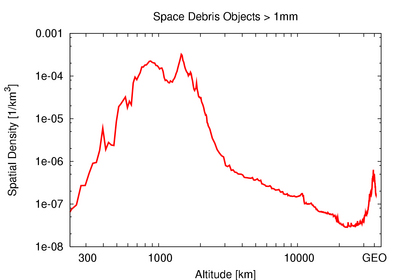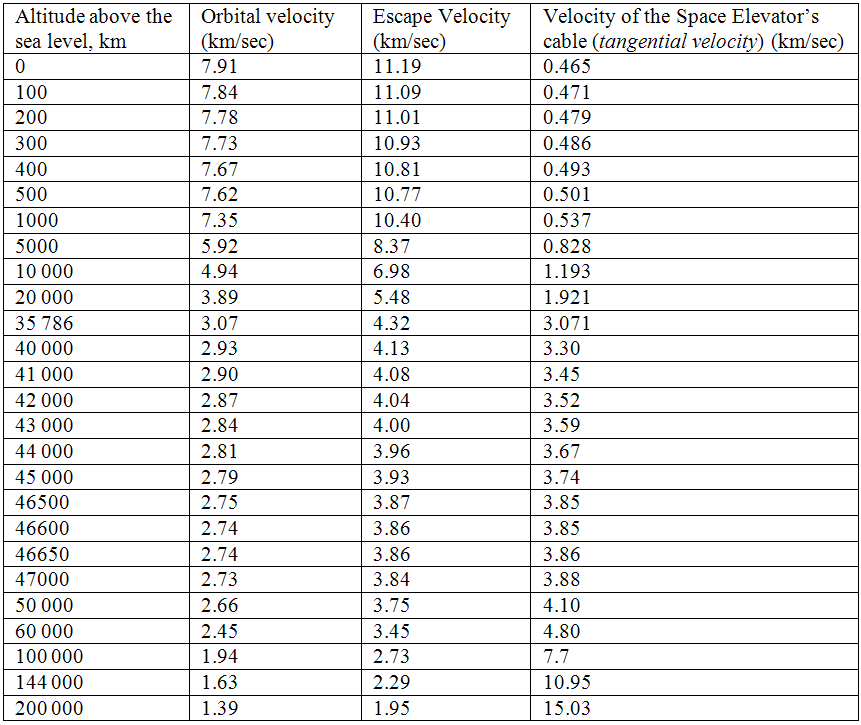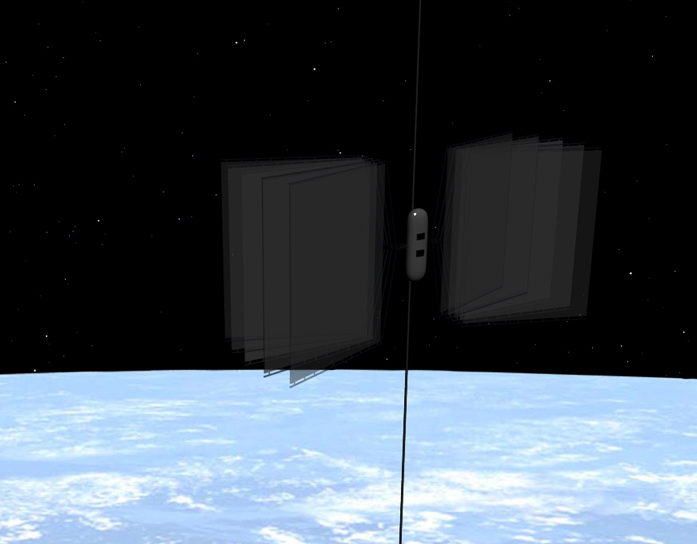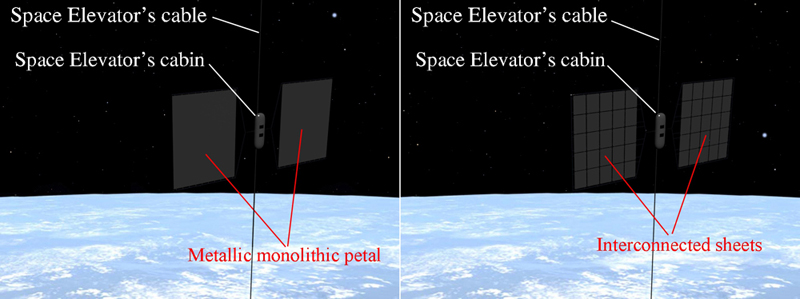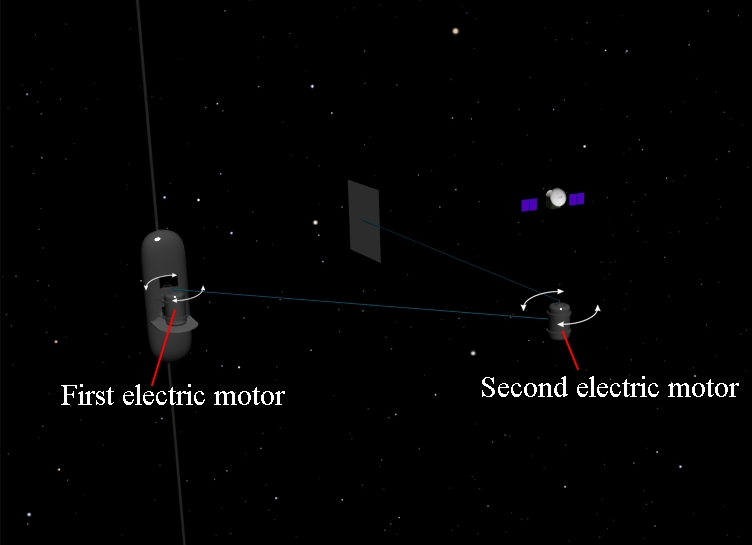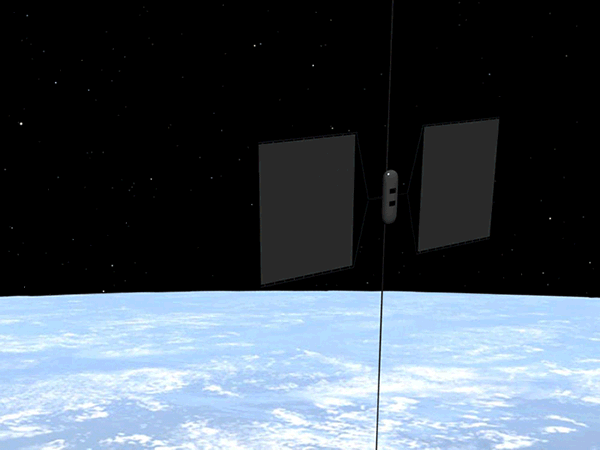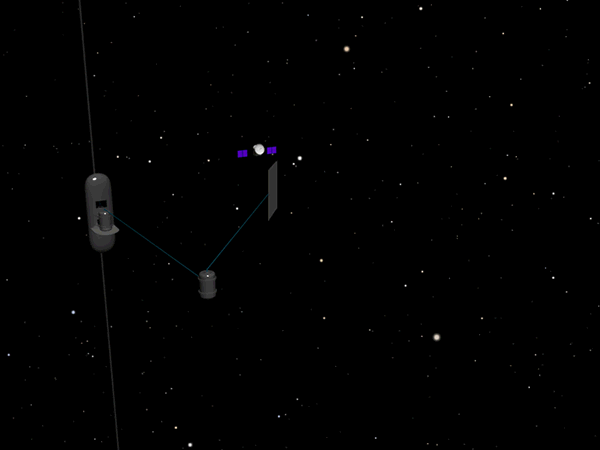OpenSpace 3
SPACE ELEVATOR VERSUS SPACE DEBRIS
Author: Mr. Giorgi Lobzhanidze; Business affiliation: Computer graphics Address: Tbilisi, Republic of Georgia; Email: giorgi9@gmail.com
Introduction
The space debris is the objects in orbit around Earth created by humans that no longer serve any useful purpose. They consist of everything from entire spent rocket stages and defunct satellites to explosion fragments, paint flakes, dust and slag from solid rocket motors, and other small particles that are much more dangerous since it is more difficult to oversee them than large objects.
Since the beginning of the Space Age in 1957 a great amount of satellites have been sent into space and this increasing number is/will be (especially in future) a great problem. According to some assessments the space debris belt will very soon make problems even for putting the satellites on the orbit around the Earth. As known, more and more countries are getting involved in space exploration and therefore number of objects (both active and “dead” satellites) in space will increase rapidly. The worst thing is that the satellites are colliding to each other and thus creating more and more little objects (their fragments) around the Earth that are much more difficult to deal with than with big objects.This effect is known as “Kessler Syndrome” 1 2. One of such collide occurred in 2009, 10 of February when the inactive satellite Kosmos-2251 collided with active one Iridium 33 above the northern Siberia with the speed of 42 120 km/h. This collision destroyed both satellites and gave birth to one more space debris cloud consisting of numerous little objects (there are at least one thousand objects in this cloud with the size of more than 10 cm) 3. If this tendency continues, if the critical density where the creation of new debris occurs faster than the various natural forces that remove these objects from orbit in space is reached and overcome, apparently after several ten years there will be some dust belt around the Earth.
To deal with the problem of space debris various ideas have been suggested such as: to "sweep" space debris back into Earth's atmosphere, including automated tugs, laser brooms to vaporize or nudge particles into rapidly-decaying orbits, or huge aerogel blobs to absorb impacting junk and eventually fall out of orbit with them trapped inside. We think that there actually could be one more way to deal with this problem and for this purpose we need to use the Space Elevator.
REMOVING THE SPACE DEBRIS AT LOW EARTH ORBIT
How the space debris objects could be generally eliminated? We could either decrease their speed or change their orbit(s) towards the Earth so that they to enter the atmosphere with the downward trajectory and then be burnt up. The first way: decreasing their current speed beyond lower than Orbital Velocity (or with another words-diminishing their kinetic energy) and thus forcing them to enter the atmosphere and their final burning could be very promising. In practice it could be reached by means of creating and building some physical obstacle on their way.
As well-known, the Space Elevator will be tall vertical structure built on equator and will have height of approximately several ten thousand kilometers or even more and its cable will cross the region called the Low Earth Orbit (LEO) where the density of space debris objects is especially very high (see picture below). Therefore, the danger caused by the space debris will be especially dangerous for Space Elevator. Hence, we think that it would be very logical and useful to use to Space Elevator in struggling against its primary obstacle-space debris.
Spatial density of space debris by altitude according to ESA MASTER-2001
Now, what kind of physical obstacle could impede space debris objects? We imagine it like some metallic petals fastened on the cabin moving along the Space Elevator’s cable. The petals will play role of the obstacle that will prevent the space debris objects and get rid of them. Their number should be two-distributed rightwards and leftwards from the cabin and they should be placed so that as more space debris objects to collide with them as possible. Of course, since the satellites (and hence space debris objects) orbit around the Earth with various inclination it would be very difficult to place the petals so that all the space debris objects to collide with them. However, we know that most of satellites orbit from West to Eastwards, therefore the petals should be placed approximately along the geographic meridians. In such case many satellites’ orbit will make the right angle (or close to right angle) to petals. We can see below on the picture how we imagine this construction:
Here the question might arise: the number of space debris object is quite high (space debris’s the total mass is estimated at 5,500 tones 4, as for their number, the large objects over 10 centimeters is estimated at 19 000, between 1 and 10 centimeters approximately 500,000, and estimates that debris items smaller than 1 centimeter probably exceeds tens of millions 5), besides it is increasing each year, they are spread at huge volume in space and how effectively such construction will deal with this problem? Our answer would be this: each satellite when orbiting around the Earth cross the equator twice during one revolution. Whatever inclination the satellite has, 0° or 90°, it has circular or elongated orbit-each satellite is crossing the equator. This crossing place may occur above any point on the Earth’s surface and sooner or later each satellite will definitely cross the place where the Space Elevator is built and will collide with these petals. The larger the petals are, the sooner this will happen.
We think that these petals should be manufactured so that the space debris objects must not reflect (jump away) from the petals. First of all the huge kinetic energy of the satellite may shift the cable and consequently the whole Space Elevator from its current position and this is undesirable. Besides, apparently no material would be able to withstand such collision. Therefore, we think that the space debris objects should pierce the petal; such collision will decrease space debris object’s speed and kinetic energy (the part of its energy will be spent for heating the metallic petals) and it (more precisely its fragments) will enter the atmosphere relatively soon. The exact time of entrance will depend on how much space debris’s object’s speed will be decreased, on their orbital characteristics (circular/elongated orbit; apparently the satellite with elongated orbit will enter the atmosphere later than the one with circular orbit) and altitude. Here these petals would operate somehow like the foam balloons (as we have already mentioned they are one of the proposed methods for eliminating the space debris), however unlike the balloons, the petals can move upwards/downwards along the Space Elevator’s cable and meet the space debris objects when necessary very quickly and this will be their great advantage-ability of eliminating the significant amount of space debris during relatively short period of time.
What will be the difference between the velocities of the satellites and Space Elevator’s cable? In other words, at which speed the space debris objects will collide with these metallic petals? Well, it depends on the altitude mainly and on satellite’s orbital characteristics-eccentricity. It is well-known that the value of the Orbital Velocity decreases with increasing the altitude while Space Elevator’s cable’s velocity (tangential velocity) increases with increasing altitude. But at Low Earth Orbit the difference between these velocities will be quite high, several kilometers per second or so. In the chart presented below we can see this difference:
We see that difference between Orbital Velocity and Space Elevator’s cable’s tangential speed at LEO (at the altitude of 300-1000 km) is quite high and the vast majority of the space debris objects are placed exactly there.
Obviously, this structure cannot work operate in order to eliminate the space debris at geostationary orbit and nearby since the difference between the velocities of the satellite and Space Elevator’s cable will be close to zero and therefore no collision will occur. However, we will discuss this issue in details a bit later in this paper.
Here we explain the mechanism of cleaning the LEO with these petals more thoroughly. When the space debris object pierces the petal it loses its speed and hence its orbit changes in the following manner: the circular orbit turns into the elliptical one with the apogee placed at the same altitude but with the perigee placed downwards. When the space debris object reaches the perigee it is exposed to more atmospheric drag and consequently it loses its altitude and eventually burn up in the atmosphere.
Here the questions arise: will the Space Elevator withstand the mass/weight of this whole construction (surely it will weigh not one metric tone)? Space elevator will have to serve many different kinds of payloads probably everyday (however it will remain unclear until the Space Elevator is really built when we will know its cabin’s ascending speed in practice) and this construction (cabin plus petals) will definitely make additional problem for its performance. Where is solution? Our answer would be this: the amount of space debris is increasing each year rapidly. Very soon it will be simply necessary to take some measurements against this problem whatever money and effort it needs. Therefore, it will be useful at least temporarily to use the Space Elevator in struggle against its primary obstacle-space debris and after ending this job the Space Elevator will work without problems. Besides, since the satellites generally orbit the Earth quite quickly, we think that such construction will be able to deal with the space debris problem very quickly, probably within several weeks of course with the condition that it works properly. After ending its job, in other words when these petals will be almost completely destroyed (pierced in many places), the cabin will get rid of them and they will simply fall on the Earth. Or, actually the cabin can go down and thus bring these destroyed and useless petals back to the Earth. As for the petals’ total weight, of course they should not be more than Space Elevator’s lifting capacity; this capacity is not well-known yet but probably it will not exceed one hundred metric tons, therefore petals’ weight should be about several ten metric tons or so.
How the pierced petals will be fallen down to the Earth? At the LEO the Space Elevator’s cable’s tangential velocity is more than Earth’s rotational speed, therefore any object released from the Space Elevator will fall down and a bit forward, that is eastwards also in order to outstrip the Space Elevator’s cable. Note, that this is favorable circumstance because this guaranties that the petals when falling down will never collide with the cable.
However, the Low Earth Orbit is filled not only with space debris, there are and will be the active satellites also and these petals could destroy them too and this is strictly undesirable. We think that the solution to this problem could be following: there is several space debris tracking systems working by a number of ground-based radar facilities and telescopes as well as by a space-based telescope, such as the United States Strategic Command's (USSTRATCOM) 6 with its United States Space Surveillance Network 7 collecting data about all kinds of near-space objects-their orbits, altitude, inclination and so on. Some other nations have also developed their own analogous systems for the same purpose, like European MASTER-2001 (Meteoroid and Space Debris Terrestrial Environment Reference (MASTER) model). These efforts lead creating the detailed catalogues holding any necessary information about thousands of artificial objects in space. More precisely, two separate catalog databases are maintained under the USSTRATCOM: a primary catalog by the Air Force Space Command (AFSPC), and an alternate catalog by the Naval Space Command (NSC). The number of cataloged objects is nearly 20,000 8 9 10. As for Europeans, the MASTER-2001 population consists of 17 800 objects larger than 10 cm 11. So, if there is information/warning from the Earth that an active satellite is approaching to these petals, the cabin will simply move upwards or downwards (actually descending is easier of course since in this case no energy will be required unlike ascending); the size of the artificial satellites generally are not high, several meters only or even less, so apparently such measurements will be absolutely enough to avoid such undesirable collision. The Space Elevator’s cabin may actually have its own radar to discover incoming and previously undetected space debris object to meet them immediately with the petals until this object(s) hit the Space Elevator’s cable.
The size, more precisely the square of the petals should be quite vast to cover large area in space for eliminate as many debris as possible. At the same time, taking into consideration the fact that all satellites sooner or later will cross the equator above some certain place above the Earth, we conclude the huge size of the petals is not final goal, and therefore some golden mean should be found for the petals’ size.
Some space debris objects orbit around the Earth with great inclined orbit (polar for example) and they may hit the petal not with the right angle but with less one and we think that this would undesirable because in case of such collision the space debris object will not pierce the petal (there will be probability that the object will jump aside from them) but will slightly change their orbiting direction. To avoid this, the cabin can rotate (see the image below) the petals around itself so that the space debris objects will collide with them at right angle.
One more thing, probably the most important: can we be sure that the speed of the space debris’ fragments after collision will be less than their initial one? It is crucial question since if fragments still have the same speed, they will stay in the same orbit and this construction on the Space Elevator with petals will be absolutely useless and even harmful because in this case the space debris objects’ amount will be increased. Therefore, it is extremely important that these petals to decrease space debris objects’ speed and also the fragments of the petals that will separate from them after collision to have speed less than Orbital Velocity on the current altitude. If this is achieved this whole undertaking will be justified. Apparently, this will be guaranteed because it is obvious that the satellite moving at huge speed when hitting almost stationery object (petals in this case) will convey its kinetic energy to stationery one and will lose the speed. The part of the energy will be spent for piercing and heating the petals. As for petals’ fragments, their speed will be increased compare to petals initial speed because of collision but still will be less than Orbital Velocity and therefore they will enter the atmosphere even sooner than fragments from the space debris’ objects.
Material for the petals
Now, what kind of material should be used for manufacturing these petals? Metal? Plastic? It is prematurely to speak about this aspect today since this is purely technical, engineering question. The primary requirement is that the material used for manufacturing the petals should not be very stiff, otherwise after satellite’s collision with petals the satellite will not be able to pierce the petal. At the same time the petals should not be very fragile, otherwise after collision it will be broken completely into little pieces. Finally we should choose such material that will enable us to manufacture the petal that will not be broken into little pieces after collision with the space debris object but will make the hole in the petal and some part of the material around the hole will be detached from the petal and then eventually fall on the Earth. One more requirement set against such petals is that they must be quite large (we think that for effective performance their area should be about several thousand square meters or more) and quite thin, otherwise they will be extremely heavy and no Space Elevator will be able to carry them.
These petals could be used for all kinds of space debris objects with the same success and this is their great advantage over other methods where there are some difficulties of removing little pieces from space, for example by means of lasers it would be quite difficult to aim at the little, almost invisible pieces in space and remove them; the petals will be exposed to collision from all size of space debris objects.
Next question: how and where these huge petals should be deployed in space? We think that from the beginning these petals must be folded and in space, more precisely at the altitude of 100 km or a bit more they will be deployed like the solar panels on the satellites are deployed. We suppose that this altitude (about 100 km above the sea level) will be convenient for deployment due to two reasons: 1) If the petals are deployed lower, for example at the altitude of 50-60 km above the sea level, it could make problems for ascending the cabin with already deployed petals since they are huge and air friction (during ascent) or winds existing at high altitudes will make problems-so deployment of the petals should be occurred in space and not in atmosphere. 2) The deployment should occur lower than LEO otherwise the space debris objects could harm not-yet-deployed petals and this is undesirable since the space debris objects should collide with deployed petals only.
Actually there could be other solution to this problem: if it is turned out that it is much easier to manufacture huge petals than deploying them into space, in this case the Space Elevator should carry unfolded/(already)deployed petals into space.
As for the fragments’ falling place, it could not be defined in advance. Of course, the Space Elevator itself will be placed at some certain place on the Earth but first of all there will be difference between speeds of the petals’ fragments and space debris objects’ ones due to their initial different speeds (we can see it on the chart represented above-on the Low Earth Orbit this difference is quite high) and this difference varies, therefore their falling place would be at the various places on the Earth. Besides, many things depends at what altitude the collision will occur. The higher occurs it the less chance the space debris object will have to be exposed to atmospheric drag at its perigee; so we think that it would be more difficult to calculate their exact falling place.
And one more issue about the construction of the petals themselves. Actually only the future practice can show us their necessary size and hence-their mass. If it is turned out that quite large petals are needed they to work properly, then one more technical question will arise: should the petals be like one monolithic sheet or should they consist of many little sheets interconnected to each other? From the technical point of view both approaches could be realized, however from the following considerations we think that one monolithic sheet still would be better to be designed and manufactured:
As well-known, the space debris mostly consists of numerous very little pieces created from satellite collision. It would be very difficult, almost impossible to follow all of them; to know exactly their location; to precisely predict their collision time to petals. If the petals are made from many little sheets interconnected to each other, then their collision to space debris dust clouds (we have already mentioned about one such cloud created in 2009) may lead to destruction of the metallic rods connecting the sheets and hence disintegrating the whole construction. If such collision destroys the rods, the petal may simply break into several above-mentioned sheets without doing its primary job, while the one monolithic sheet will have more chance to withstand and hence maintaining its integrity and to continue its job. Here we can see both probable kinds of petals:
Some ideas about metallic rods connecting the Space Elevator’s cabin with petals
First of all: what kind of cross-section should they have? We think that the best solution would be the oval one with the sharp edges directed towards satellites’ moving direction because if some satellite hits the rods (instead of hitting the petals) then the sharp-edged rod would have more chance to cut the satellite while the circular-section rod would be relatively easily destroyed at such collision and this would lead to complete destroying the whole structure.
Also, there is no necessity the rod to cover/connect the petals from all four sides but it (the rod) should connect the cabin to petal(s) only. Besides, it would be useful if this rod is a bit elastic since at collision with space debris object the rigid rod may cause Space Elevator’s cable’s shift (due to satellite’s huge kinetic energy) and this would be undesirable; if the rod is elastic, then the collision will cause petals’ vibration only relative to the cabin.
Additional petal
For protecting this whole structure, more precisely for protecting the cabin itself from undesirable collision the additional protective petals could be deployed in front of the cabin. As we imagine, there actually could be pair of petals with their common “nose” highly directed forward. This pair should operate in a bit different way-the space debris objects will not pierce them but hit them at low angle, change their flying direction and hit the main petals. We think that such measurement, installing these additional petals is absolutely necessary because the cabin and the cable must not be damaged by the collision in no circumstances, otherwise it may lead to destroying the Space Elevator that is absolutely intolerable. In the picture below we can see these protective petals:
In case of emergency if one of the petals is lost will the second one be able to continue operating? Well, mainly it depends on the remained petal’s mass and Space Elevator’s lifting capacity. If it turned out that the Space Elevator is able to withstand the load (that is second petal) hanging at one side only, then the performance should be continued until the second petal is completely pierced and released down. Otherwise the remained petal should be immediately released to avoid cabin’s tilt.
What time it will take this structure to continue operating after ending its job again? Mainly it depends on cabin’s ascending velocity and on the time needed to replace pierced petals with new ones. As for ascent velocity it is not well-known yet, however according to current speed of the climbers at the space elevator games (about 2 m/s) it would take about 80 days to reach the geostationary orbit; but the Low Earth Orbit that is especially filled with space debris and needs to be cleaned first of all is approximately hundred times closer to the Earth’s surface, therefore one day would be absolutely enough for the cabin to get this orbit and begin operating, even the less time will be needed to descend to the Earth. Some amount of time will be taken to replace old petals with new ones (this time is approximately directly proportional to petals’ area). So, as we propose this whole structure could actually work in a continuous mode (this is very important) until the Low Earth Orbit is cleaned enough.
This work actually has got some unfinished issues, such as: the petals may not withstand the heat generated by the collision-so the melting temperature and heat capacity of the materials used for manufacturing the petals should be quite high. In space the petals could also deform and change their shape due to high temperature caused by collision. The probable solution to this problem could be using such material for petals that will enable to emit the heat in the form of infrared radiation as quickly as possible. Currently we shall leave solving these problems to future since actually it is technical, engineering problem and does not directly concern to our proposal.
This method described in this paper has got the following advantage: we do not need to allocate a huge amount of money to realize it. The whole point is that the Space Elevator will be built for other purpose-to decrease payload’s sending cost to space and the necessary money will be allocated for it. And as soon as the Space Elevator is built it should be used first of all in struggling against its primary obstacle-the space debris and when it will be done the Space Elevator may begin working to deliver the payload into space. So, struggling against space debris is Space Elevator’s additional but necessary function. If it was not so, nobody would build such an expensive structure as Space Elevator only for struggling against space debris, and manufacturing the petals and fastening them to the Space Elevator’s cabin does not demand a lot of money.
REMOVING THE GEOSYNCHRONOUS SPACE DEBRIS
As we have already said, the space debris objects at/near the geostationary orbit cannot be removed by means of the technology described earlier in this paper and we explained why. Therefore, for this purpose a bit different approach should be used and we conventionally call it space broom. We imagine it in the following manner:
The Space Elevator’s cabin reaching the geostationary orbit stops at this altitude and then deploys the petal with very long rod consisting of two parts and connecting the petal to cabin. The cabin with the electric motor will move/rotate the rod with petal so that it to touch the satellite against its own orbiting direction, thus slows it down and turn its orbit into ellipse. This ellipse will have the same apogee that it had before but with much lower perigee where the satellite will nearly touch atmosphere’s rarefied layers and consequently due to atmospheric drag its orbit would decay. Because of geostationary orbit’s altitude-35 786 kilometers quite high delta-v would be needed for de-orbiting, about 1,500 m/s. The petal should touch the satellite softly (in order not to break it into little pieces since it would lead multiplication of the space debris) it and then very quickly increases the push to reach the above-mentioned delta-v. After this, space broom (thus we call this long rod with the petal) will deal with next satellite to remove it.
Under such approach we do not need the huge petal (its area should be commensurable to satellite’s size), besides the petals can be made of any material that would withstand such insignificant touch to satellite. Petal’s inner side (that actually touches the satellite) should be covered with some soft and porous material that would guarantee soft touch to satellite. But from the other hand, the rod connecting the Space Elevator’s cabin to the petal should be quite long due to following reason:
As well-known, the geostationary satellites are “fixed” relative to Earth’s surface, the same concerns the Space Elevator. This means that these satellites are fixed relative to Space Elevator and its cabin and are placed (actually “will be” would be more suitable phrase) at some certain distance from it and as a rule these distances are equal to hundreds and thousands of kilometers (to have clear idea about these distances, it would be enough to recall that the circumference of the imaginary circle at the geostationary altitude around the Earth is equal to 264 924 kilometers). Therefore, to get them very long rod would be needed since it is no likely that exactly space debris objects to be found in the close vicinities of the Space Elevator since operating and “dead” satellites are distributed at the geostationary orbit approximately equally. The longer this rod is the more useless satellites it can remove from the orbit and lower down to the Earth.
But of course not all of the geostationary satellites are the space debris; some of them are still operating satellites that must not be touched by space broom, but in fact it may touch them when deploying in space and thus accidentally change their orbits (this is absolutely intolerable, the geostationary satellites should have the circular orbit at the certain altitude-35 786 km). This is the reason why we should use the space broom with the rod consisting of two parts. The first electric motor installed on the Space Elevator’s cabin will move/rotate the whole space broom around the Space Elevator’s cabin while the second electric motor installed between these two parts will move/rotate the second part so that the petal (fastened to the second part’s end) to be in front of satellite, then touches this satellite and lower it down to the Earth as described above. So, both electric motors will operate to aim at the necessary satellite that should be removed from the orbit; the second motor will also serve to pushing the satellite. This situation is depicted on the image below:
In order to maintain stable push during the process of de-orbiting we think that the petal should make the right angle to satellite’s trajectory, otherwise the satellite can slide out from the petals. Therefore we think that the third electro motor should be installed between the rod’s second part and the petal that will control petals’ attitude towards the satellite which we intend to remove from its current orbit.
Of course, rotating this two-part rod needs a lot of energy; therefore the rod should be made of very light material and can be actually very thin. In fact, the only requirement set against the material is that is must not be elastic, but it must be rigid, otherwise when moving the long rod it may actually vibrate and it will probably make problem for precise targeting the needed space debris object.
Generally, there it is possible space broom’s a bit different way of operating. As mentioned above for de-orbiting the geostationary satellite quite high delta-v would be needed-1,500 m/s while for escaping from the Earth a bit less delta-v is required. Indeed, the satellite’s speed at the geostationary orbit is equal to 3 km/sec and the value of the Escape Velocity at this altitude is equal to 4.32 km/sec; this means that for removing the geostationary satellite we can either de-orbit it and for this purpose 1.5 km/sec in needed, or we can accelerate the satellite and in this case the necessary delta-v is equal 1.32 km/sec (this is the difference between the values of the Escape Velocity and Orbital Velocity at the geostationary orbit). As we see it is a bit easier for the space broom to force the satellite leave the Earth rather than to lower it down. The detailed way of operating of the space broom would be absolutely the same-the petal will push the satellite softly, and then very quickly increases the push to reach the needed velocity. In fact, the only difference will be the circumstance that when we intend to remove the satellite placed eastwards of the Space Elevator we should accelerate it while during removing the satellite placed westwards of the Space Elevator we should decelerate and lower it down. The reason of it is that the Earth (and the Space Elevator also) rotates from westwards to eastwards, therefore when accelerating the satellite it is possible to send it out from the Earth’s orbit without fearing that it may actually hit the Space Elevator or its long cable and this would be possible if the accelerating satellite is placed eastwards of the Space Elevator, that is in front of this structure; as for the satellites that we intend to decelerate their orbits (already turned into ellipse) they can collide with the Space Elevator and its cable in any case (without depending at which side of the Space Elevator they were placed from the beginning) and to avoid such undesirable collision we can use the very structure of the pair of petals described in the first part of this paper. However, we think that if the space broom when decelerating the satellites also changes/tilt their flying trajectory with the several degrees then satellite’s path will not cross/hit the Space Elevator and its cable. To achieve this, the space broom should push the satellite backwards and also a bit laterally.
Also, we think that it would be useful the petal to have some video camera and/or radar to identify exactly the very space debris object that should be removed from the geostationary orbit. Of course, the ground-based stations with their database can indicate precisely enough where to the petal should be directed for pushing the satellite; however we think that to make sure that the space broom is removing the needed space debris object and not the operating satellite the video camera and/or radar would be good assistant.
Now, how the space broom could be carried from the Earth and then deployed in space? We should not forget that space broom’s proposed length should be hundreds or thousands of kilometers, otherwise its performance would be ineffective and hence its building would not be justified; besides its rod should consist of two parts. To our mind the Space Elevator’s cabin when ascending should carry rod’s first part’s initial end (the one that is actually fastened to the cabin with the first electric motor) while the other end with second part will be placed on the base station near the Space Elevator. When the cabin reaches and overcomes the altitude equal rod’s first part’s length then it would carry the second part along the Space Elevator’s cable, just like we raise the chain with its rings from the floor in our hands. After reaching the geostationary altitude that is being in the state of weightlessness, the electric motor(s) will position the rod in the needed location and the space broom will begin operating as described above.
Source of energy for space broom
Two electric motors for moving the space broom and precise aiming at the space debris object(s) need source of energy. This problem generally is linked to the problem of getting the energy for the Space Elevator as such. Therefore, we think that when this very problem is solved in a general sense, the part of this energy could be actually distributed for operating the space broom (the Space Elevator’s cabin does need energy when hanging fixed on the cable at the geostationary altitude unlike lower altitudes where the cabin should use the brakes to maintain some certain altitude). As for alternative source of energy, we could use huge solar panels or nuclear reactor placed at Space Elevator’s cabin; as concerns transmitting the energy to second electric motor and video camera/radar, it could be accomplished through the rod (in this case the rod will act as ordinary electric cable) itself or by means of microwave/laser beam.
One important issue about the space broom. Generally nobody tries to de-orbit the geostationary satellites since it requires huge amount of fuel\energy and this is justified because it would be too expensive to afford sending the satellite into space with additional fuel for de-orbiting. But the space broom is a different matter since for its operating we need spending not the fuel but the energy that we can get from the solar panels in a continuous mode.
How much time it will take the space broom to clean the geostationary orbit from space debris objects? We think that just after the space broom finds and directs downwards the aimed object it should continue this job-finding and removing other geostationary space debris objects; in other words we propose that the space broom should begin its performance with removing the outermost (relative to Space Elevator’s current position) space debris object that it can physically reach with its rod’s full stretch (in this case the rod will be almost fully opened). As soon as the first object is removed the space broom should remove the second one and so forth until removing all space debris objects lying on one certain side of the Space Elevator, for example to the east. After finishing this job the space broom should do the same work on the other side of the Space Elevator; after doing this its performance will be done and we can descend the space broom down to the Earth. So, how much time will be spent on this? This time approximately depends on detailed information about exact location of the geostationary space debris objects; the more detailed we know this, the less time will be spent for searching and aiming at the object that we intend to remove; this time also depends on how quickly the electric motors can work, the mass of the rod and on the energy distributed for the space broom. We propose that this is the matter of several days or so, however only the practice can show us the space broom’s real rate of performance.
When describing above the space broom’s operating mechanism we mentioned that the petal after touching softly the satellite should increase the push very quickly. Why it is so important? For de-orbiting the satellite we should decrease its speed by 1.5 km/sec and when doing this the petals carrying the satellite will cover some certain distance in space. It would be very useful if this distance is as short as possible because if this distance is too high the satellite can actually hit to other ones placed at the same orbit. In other words, satellite’s speed should be accelerated/decelerated as quickly as possible. This circumstance by the way somehow restricts the amount of the geostationary satellites that can be removed by the space broom because if the satellite is too far from the Space Elevator then the space broom will be able to reach it as such, but it will not be capable to decelerate the satellite properly.
As we mentioned above the geostationary satellites are approximately equally distributed at their orbit and that the circumference/length of this orbit is quite high-264 924 kilometers. To clean this orbit completely from the useless junk very long rod would be needed for the space broom and it is not likely to be designed and manufactured from the technical point of view. This means that the space broom is capable for cleaning its near vicinities only, as for cleaning the whole geostationary orbit this construction should be delivered down after finishing its job and then carried in space by other Space Elevators (of course if they are built) built at other places on the Earth.
And one more note about space broom’s possible working range. As we have already seen the number of the space debris objects that can be removed with this construction mainly depends on rod’s length, but nothing impedes us to use it for removing not only the geostationary space debris but also the ones orbiting the Earth at near altitudes-higher and lower. The mechanism of operating would absolutely the same with the exception of one detail-when eliminating the object moving relative to space broom this very circumstance (that is difference between the speeds of non-geostationary satellite and space broom fixed relative to the Earth) should be taken into consideration when aiming at the moving object, the same concerns the geosynchronous satellites that are not fixed relative to the Earth and Space Elevator unlike geostationary ones.
In practice using the methods described in the paper presented here with other ones will enable the humankind to clean the low and high Earth orbits from the space debris and to make the both manned and unmanned spaceflights safe.
References:
1. http://en.wikipedia.org/wiki/Kessler_syndrome
2. http://webpages.charter.net/dkessler/files/KesSym.html
3. http://www.space.com/news/090211-satellite-collision.html
4. http://www.guardian.co.uk/science/2008/feb/24/spaceexplorationspacejunk
5. http://orbitaldebris.jsc.nasa.gov/faqs.html#3
6. http://en.wikipedia.org/wiki/United_States_Strategic_Command
7. http://www.au.af.mil/au/awc/awcgate/usspc-fs/space.htm
8. Neal, H. L.; S.L. Coffey, S.H. Knowles (1997). "Maintaining the Space Object Catalog with Special Perturbations". Astrodynamics (Sun Valley, ID: AAS/AIAA) v.97 (Part II): 1349–1360.
9. Vallado, David (2001). Fundamentals of Astrodynamics and Applications. Torrance: Microcosm Press. p. 958. ISBN 1881883124.
10. Hoots, Felix R.; Ronald L. Roehrich (December 1980). "SPACETRACK REPORT NO. 3 - Models for Propagation of NORAD Element Sets". ADC/DO6 (Peterson AFB: Project Spacetrack Reports, Office of Astrodynamics, Aerospace Defense Center).
11. http://www.esa.int/esapub/bulletin/bulletin133/bul133f_klinkrad.pdf page 5
Appendix:
Animations illustrating the cleaning process:
At Low Earth Orbit:
At Geostationary orbit
